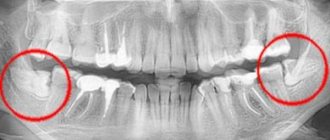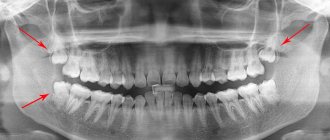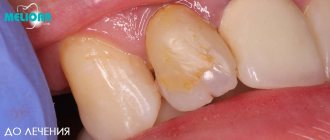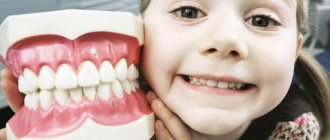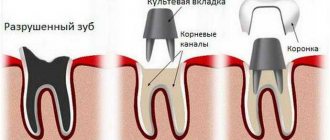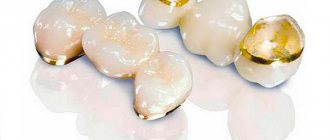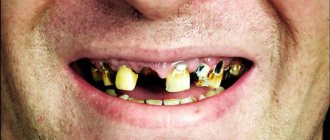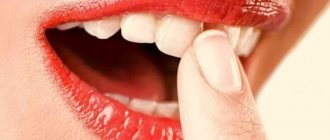Orthodontist, Ph.D.
Tatyana Vladimirovna Gevorkyan Crooked front upper and lower teeth
.
Let’s imagine a common situation: the teeth were straight, but recently they began to notice that the teeth began to shift and run into each other. We open up the Internet and begin to self-consult and search. Oh, miracle, we found it! your wisdom teeth
(third molars) have ruined the position of your teeth. Therefore, the curvature of the front teeth occurred. Or lower teeth. These bad wisdom teeth need to be removed, and then all the other teeth will straighten out on their own. There will be a free place! There is no need for an orthodontist here. There is no limit to joy. Let's go, delete it. We are waiting for alignment, but it does not happen. Why? Because your insight about wisdom teeth is a myth.
Yes, with their respectable name “wisdom teeth”, very often they behave completely “unwisely” and bring a lot of trouble. Your assumption seemed quite logical: there was little space in the oral cavity, in the dentition, the wisdom teeth displaced all their neighbors (that is, there was movement of the teeth), which means that after removing the stubborn figure eights, a vacant place will appear and all the teeth will return to their original position on their own. Unfortunately no! Of course, you can try to wait, watch, observe your sensations, again and again carefully examining the upper row of teeth, then the lower, in the mirror, but there will be no significant visual effect. You can believe it. It is paradoxical, but the same law of orthodontics that all orthodontists know about: that the ligamentous apparatus of the teeth pulls the teeth into their original position as soon as the orthodontic force stops, does not work here. Even 50%.
Let me explain the above. The law of orthodontics is very simple
: if you undergo a course of treatment (on anything) and do not consolidate the result obtained, then everything will return to the starting point (or close to it). The explanation for this is very simple: the tooth has a ligamentous apparatus, which is rebuilt much longer than the tooth changes its position. Accordingly, as soon as the orthodontic load is removed from the tooth, the ligaments tend to return it to its original position.
Why does a wisdom tooth cause problems?
Why is wisdom tooth eruption so often difficult? The fact is that a wisdom tooth begins to grow when a person’s entire dentition, both upper and lower, is already fully formed. If the wisdom tooth is positioned incorrectly in the gum, it can cause dental complications.
Difficulty erupting wisdom teeth
The wisdom tooth may not completely cut through the gum; in fact, it may remain partially or completely in the gum. This leads to the formation of a kind of gum “hood” at the site of tooth eruption, which is an ideal place for the deposition of food debris and, consequently, the proliferation of pathogenic bacteria. There is a possibility of infection of the gum tissue. Surgical interventions may be indicated to facilitate the eruption of wisdom teeth. All procedures in our clinic are performed under anesthesia, you will not feel anything at all.
Narrow jaw
Also, wisdom teeth may have difficulty growing if the person’s jaw is very narrow. In this case, the wisdom tooth seems to make its way through, affecting the entire dentition. The wisdom tooth puts force on neighboring teeth as it grows, which causes severe pain and even displacement of the dentition. Thus, crowding of the front teeth of the lower or upper jaw is often the result of an incorrect growth process of the wisdom tooth.
Crooked tooth roots
Incorrect direction of wisdom tooth growth can also be caused by crooked roots. In this case, the wisdom tooth does not grow upward, but as if to the side, resting its crown on the adjacent tooth. The result is similar to the previous case - displacement of the dentition and inflammation in the gums appear.
But even when the wisdom tooth has already grown, it can still cause some problems in the oral cavity. If the wisdom tooth is in the wrong position, it can lead to several complications at once, the main of which are:
- high susceptibility of the wisdom tooth to carious lesions;
- more intense formation of plaque and tartar than on other teeth;
- violation of diction in a person;
- frequent biting of the inner mucous membrane of the cheeks;
- increased bleeding of gums;
- frequent and severe swelling of the gums, redness;
- problems with daily oral hygiene.
If you experience discomfort or pain in the area where your wisdom teeth grow, make an appointment with your dentist. The doctor will take an x-ray and offer you effective treatment to relieve your symptoms. Our phone number in Moscow is 8 (495) 221-21-18 .
Registration is also possible via the Internet - just fill out the registration contact form. Dentistry on Shchelkovskaya is located near the Shchelkovskaya metro station. It is convenient to get to us from Preobrazhenskaya Square and from the Izmailovo district. If you have acute pain, please notify the administrator, and they will find the next appointment time for you.
Teeth straightening – the price of the issue
Methods for straightening crooked teeth have been described above. Now let's take a closer look at the cost of each of them:
- Installation of braces. The cost depends on the type of system used. For example, the price of sapphire braces starts from 20 thousand rubles. Metal systems are cheaper (about 10 thousand rubles), and the most modern, invisible lingual braces will cost 50 thousand.
- Correcting small bite defects with mouth guards costs from 50 thousand rubles per jaw.
- An initial course of bite correction with a trainer from a qualified specialist will cost 15 thousand rubles. The advantage of this treatment method is that it is absolutely painless, does not harm the teeth and can be used to correct the bite even in young children.
- Veneers and lumineers. The cost of restoring teeth using these plates depends on many factors. First of all, the price varies depending on the material and the manufacturing company. In addition, the final cost depends on the number of teeth being corrected. On average, the price of one veneer ranges from 10 to 12 thousand rubles including installation.
- The cost of dental restoration is determined individually, depending on the materials used and the location of the teeth. For example, the price of composite restoration of crooked front teeth starts from 7 thousand rubles. It is cheaper to restore side teeth: from five thousand.
If you plan to install crowns, the price will depend on the material used. In addition, additional costs may arise during treatment for adjustments to alignment systems.
What diseases can wisdom teeth cause?
An incorrectly erupted or incompletely erupted wisdom tooth can cause the development of a number of oral diseases.
Wisdom teeth cause gingivitis
First of all, if wisdom teeth erupt incorrectly, there is a risk of developing gingivitis - an inflammatory process in the gums. Gingivitis can be caused by the fact that oral hygiene in the area of the wisdom tooth is not always effective - a toothbrush simply cannot properly clean this hard-to-reach corner. At the same time, the activity of pathogenic bacteria leads to the onset of inflammation in the gums.
Development of pericoronitis
A wisdom tooth can also cause pericoronitis. The risk of this disease is especially high if the wisdom tooth has not erupted enough or has not erupted at all. Pericoronitis develops due to food debris getting into the gingival “hood”. This disease is accompanied by severe toothache, swollen gums, bad breath, and discomfort when eating, talking, or brushing your teeth. In some cases, an increase in temperature may be observed. If pericoronitis progresses to a deep stage, then there is a high probability of developing more dangerous diseases - periostitis (inflammation of the periosteum of the jaw) and ostiomyelitis (bone damage).
Development of periodontitis in the area of wisdom tooth growth
The inability to carry out thorough hygiene of the wisdom tooth area can become an impetus for the development of periodontitis - damage to the tissues surrounding the tooth. Periodontitis in the area of the “action” of the wisdom tooth develops much faster than in other areas of the oral cavity. If you do not pay attention in time to the presence of plaque or tartar, bleeding, or loose teeth, the progression of the disease can lead to tooth extraction.
Network of dental clinics KANO and physical therapy clinic KANO
The human body is an inexpressibly complex system. Everything is closely intertwined in it, even if the relationship does not seem obvious at first glance. Therefore, qualified treatment and recovery require an integrated approach from thinking doctors of different specialties. Such a unique concept can be found in Minsk in the KANO network of dental clinics and the KANO physical rehabilitation clinic.
Dentists of the KANO clinic network will provide comprehensive treatment for dental problems of any complexity: from professional oral hygiene to high-tech digital prosthetics and Zygoma zygomatic implantation.
Physical Therapy Clinic KANO
And at the KANO physical therapy clinic, specialists will offer you a comprehensive program for posture correction and joint rehabilitation, which includes physical therapy and therapeutic exercises, physiotherapy, kinesiotherapy and massage. A holistic approach brings full results!
What complications can a wisdom tooth cause?
In all cases of problems with the growth of wisdom teeth, identical symptoms are observed. The most common companions to the eruption of wisdom teeth include:
- severe toothache;
- inflammation and swelling of the gums;
- crowding of other teeth in the row;
- numbness of the jaw due to disruption of the eruption of wisdom teeth.
Sometimes, when a wisdom tooth erupts, a person’s body temperature rises, pain in the ears and head appears, and general weakness of the body is observed. If you discover symptoms of complications that accompany the growth of a wisdom tooth, then you need to contact your dentist as soon as possible. Only a doctor is able to assess the eruption of wisdom teeth and determine the extent of its impact on neighboring teeth.
When dealing with a complaint in the area where wisdom teeth are located, the dentist will order an x-ray to determine whether the roots of the tooth are crooked or not, as well as to understand how crooked the wisdom tooth itself is and in what position it is pressing on other teeth. X-rays also help predict the behavior of a wisdom tooth in the future, even if it does not currently have a noticeable effect on the dentition, and take preventive measures in time.
How much does it cost to fix crooked teeth?
If you want to know what to do about crooked teeth, the first step is to consult a qualified orthodontist. He will determine which method is best to use and install a corrective system.
Modern dentistry offers a wide range of systems for correcting crooked teeth and malocclusion. They all vary in cost. It is important to choose not only a correction method that is suitable for the price, but also to contact qualified specialists.
There are not so many orthodontists with the required qualifications (as well as dentists of other specializations), but at the 32 Dent clinic there are specialists who install braces, veneers and other bite correction systems for adults and children. It’s also nice that the clinic has fairly affordable prices, so almost all patients can correct their crooked teeth.
How to relieve pain when wisdom teeth erupt
This question must be of interest to every person for whom the growth of wisdom teeth causes at least the slightest discomfort.
Dentists recommend rinsing your mouth with antiseptic solutions to relieve pain when wisdom teeth erupt. The following solution is very effective. Dissolve a spoonful of salt, a spoonful of soda and two or three drops of iodine in a glass of hot water. Then you need to wait a little until the water temperature drops to the optimal and safe level, so as not to damage the gums and mucous membrane of the mouth, and then rinse the oral cavity with the composition. In order to relieve pain when wisdom teeth erupt, you can also use analgesics.
It should be understood that the methods listed can only provide temporary relief in the event of severe toothache. To get rid of emerging and potential problems during teething and to treat wisdom teeth, you must consult a doctor.
Healing after surgery
Your tooth is removed under local anesthesia, so you will not experience pain. After the procedure, it is important to follow the surgeon's advice. He can suggest you a painkiller that is suitable specifically for your case. You should rinse your mouth on the first day, do not smoke, do not drink alcohol, and be careful with hot, cold and spicy foods.
If you follow all the recommendations, healing will occur quickly and painlessly. In our Family Dentistry you can get a free consultation on this matter, you just need to use the code word “FAMILY”.
Wisdom tooth: treatment or removal
Treatment of wisdom teeth, as far as possible, is carried out therapeutically. If the walls of the tooth are strong and the nerves are not affected by caries, the tooth is filled in the same way as with other teeth. Treatment of wisdom teeth does not differ from the standard procedure.
If the tooth grows in the wrong position and has curved roots, then the best way to get rid of problems with wisdom teeth is to remove them. Tooth extraction helps to avoid the development of oral diseases and keep the dentition beautiful and straight. If the wisdom tooth has grown correctly and does not cause you any inconvenience, then, of course, there is no need to remove it simply because it is the eighth tooth.
Dentistry and physical rehabilitation: relationship
The concept of osteopathic dentistry should not be overlooked when treating teeth.
What does it mean? During orthodontic treatment, in one hundred percent of cases, the position of the teeth changes and, accordingly, the contacts between the teeth. At the same time, the vector of application of chewing forces and the distribution of chewing load change. That is, after treatment we get a completely different bite.
Correcting the bite without concomitant treatment of postural disorders by an orthopedist will lengthen the time it takes to straighten teeth and increase the likelihood of relapse - that is, the return of teeth to their original uneven position.
We have the same effect with total prosthetics and reconstruction of all teeth using All-on-4/6 technology. After treatment, the jaw relationship, muscle tone and position of the temporomandibular joint changes dramatically. Do you think such dental intervention will affect other parts of the skeletal system?
The balance of forces changes, and skeletal structures will strive to restore balance, often at the expense of healthy joints. After all, the body has already developed its balance over many years and adapted. It may not have been entirely aesthetically pleasing or symmetrical, but it was a balance.
Therefore, after correcting the bite and aligning the “Hollywood”, the problem may arise from an unexpected front - in the form of back pain, for example.
There is also the other side of the coin: it is impossible to correct your posture without making changes to the blocked malocclusion. You can go to massage therapists and kinesiotherapists for years, get temporary relief and wonder why the pain comes back. And the answer is on the surface - you need to pay attention to correcting the bite.
Dentistry and physical rehabilitation: relationship
Complex treatment in combination of methodologies
After reading this article, you understand why the cooperation of a competent orthodontist and an orthopedic rehabilitation specialist is important when correcting spinal curvatures and crooked teeth.
If you look from the position of osteology, ignoring problems with posture leads not only to aesthetic problems. Disorders in the musculoskeletal system lead to osteochondrosis, radiculitis and other diseases of the spine.
At the same time, from the dental side, malocclusion threatens problems with the temporomandibular joint, pain in the teeth, gum and periodontal diseases, abrasion and loosening of teeth, and a high level of caries.
And if we take into account that these problems complement and mutually aggravate each other, it becomes crystal clear that they need to be treated comprehensively. An orthopedist-rehabilitator should participate in the restoration of the bite along with an orthodontist, and in parallel with the correction of posture, teeth should be restored.
Complex treatment in combination of methodologies
Prevention of crooked teeth
The main measures aimed at preventing tooth curvature are:
- giving up the habit of touching growing teeth (including with the tongue);
- inclusion of solid foods (crackers, carrots, radishes) in the diet;
- giving up the habit of cracking nuts and seeds with your teeth, gnawing writing utensils and other hard objects;
- nasal breathing.
In addition, you can prevent the development of pathology by regularly undergoing preventive examinations at the dental clinic. The problem of crooked teeth is much easier to eliminate in the very first stages of its development.
Therefore, there are contraindications to orthodontics:
- blood diseases;
- tuberculosis;
- HIV;
- diabetes;
- immune system diseases;
- some forms of osteopathy, osteoporosis;
- most mental illnesses;
- poorly compensated diseases of internal organs.
Interventions in the oral cavity should not be performed if there is bleeding or poor wound healing. The patient may harm himself with the orthodontic device, or it will hinder the actions of resuscitators in the event of decompensation of a chronic disease.
Important: The doctor’s duty is to primarily pay attention to vital organs and take into account the potential risks of orthodontic operations. Patients should be understanding about prohibitions and not insist on interventions that are dangerous to life and health.
Treatment of children
Children have fewer aesthetic requirements, but the ability to quickly remove orthodontic appliances is important. Taking this into account, removable plates are usually used. In large cities where dental care is developed, almost everyone has seen elementary school students with “braces” in their mouths. Devices sparkling with chrome and nickel are attractive in their own way, and are even perceived by schoolchildren as decoration. Not everyone's parents allow them to wear earrings or get piercings, but a dentist can legally put a nice toy on your teeth.
Records have many useful functions. In addition to correcting the position of the teeth, they normalize the functioning of the jaw muscles and promote the proper development of bones. The tongue and cheeks stop putting pressure on the crowns.
Unfortunately, treatment with plates is only available up to a certain age - 10-12 years. Then all the baby teeth fall out, and there are many permanent teeth in front. Other correction methods are needed.
Important: Orthodontic treatment of patients under 18 years of age requires the written consent of their guardian adults.
Treatment for adults
The most effective and popular method of correcting uneven teeth in adults is braces. But there is an alternative: transparent removable aligners or prosthetics.
Prosthetics show good results when there are wide gaps between all front teeth. In this case, no matter how you correct the position of the crowns, your smile will not become more beautiful. But dental onlays made of durable ceramics matched to the color (veneers, lumineers) expand natural teeth. The crowns are ground down and you need to wear dentures for life. Their average service life is several years. The patient should keep this in mind when contacting the dentist.
Restoration with specific composite materials also helps. It is better to resort to it if there are carious cavities and other shape defects in the crowns. Composites require regular polishing, but in some cases they are the best choice (deep caries on the incisors).
Transparent aligners (aligners) are made from polymers with the optimal combination of rigidity and ductility for this purpose. They are put on several adjacent teeth, often on all the front teeth at once. Aligners are worn almost 24 hours a day, being removed for eating and brushing teeth.
Advantages of mouth guards:
- easy to remove;
- invisible from the outside;
- safe for children;
- a person quickly gets used to them;
- diction is maintained;
- mucous membranes are not injured;
- tooth enamel is not damaged.
Disadvantages of aligners:
- suitable only for the simplest dental defects;
- Only a highly qualified dentist can make mouth guards.
Mouthguards exert little pressure on the teeth and cannot correct defects such as rotation of the crown around its axis. But in simple cases, patients find it more pleasant to wear them than braces.


